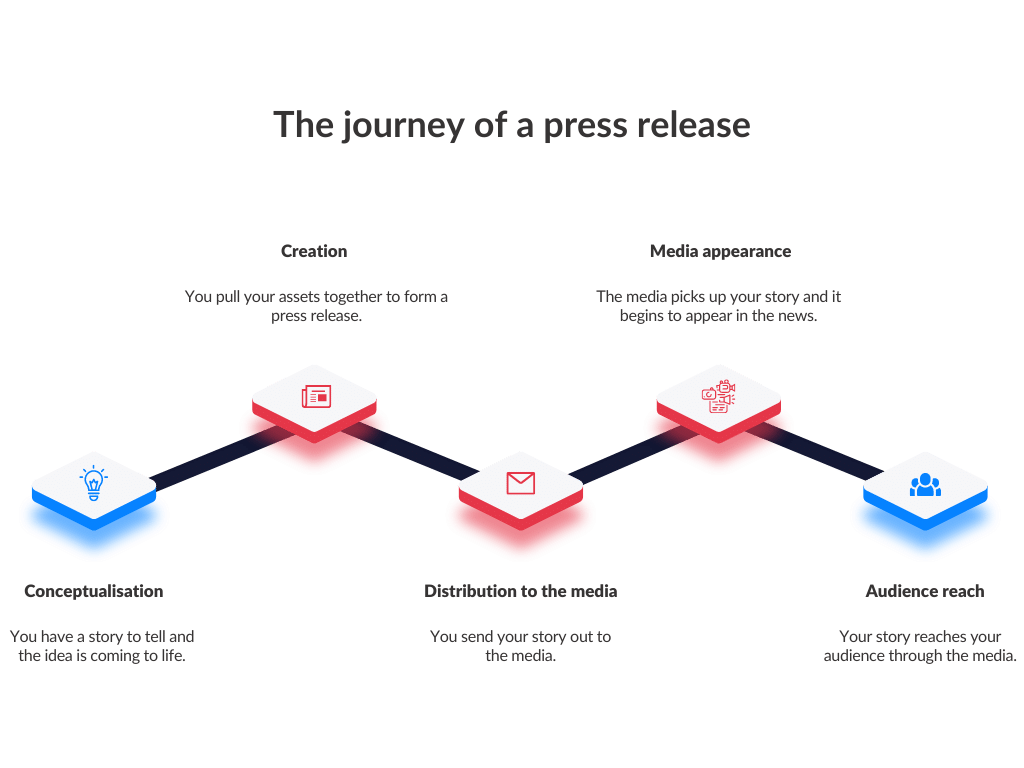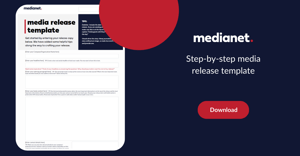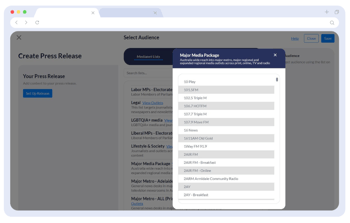The ultimate guide to PR media campaigns
Your complete step-by-step guide to creating a PR campaign using press releases.
First, what is PR?
Public relations is all about cultivating and maintaining a business or individual’s positive reputation, through earned or unpaid media. Unlike marketing or advertising, which are typically focused more on selling a particular product or service, PR is all about promoting an overall image.
Owned, earned and paid media — the pros and cons
With so many diverse PR strategies being used today, it can be hard to know what will deliver the greatest results for your brand.
How do I make a PR campaign?
A PR campaign is made up of several unique parts. Before you start, think about what you want to achieve from the campaign, what audiences you’re hoping to reach, and how you want your brand to be perceived.
|
Three steps to creating your own PR campaign:
|
Setting a goal and defining an outcome
Carefully consider why you are preparing your campaign and decide on what you want to achieve. Your goal will help you structure and build your campaign as well as analyse it’s success at the end of it.
Deciding on who you want your campaign to reach
There are two audiences that you will need to consider for your campaign:
- The end audience that will be reading and engaging with the media surrounding your campaign.
- The journalists or media contacts that will be writing about your campaign. This audience will be covered in the “How to send a press release” section below.
Your goal will help you to determine who you want your campaign to reach.
For instance, if your goal is to bring awareness to your product or service, then your audience might be those who would use or benefit from your product/service. If you are instigating change in a sector, then your audience might be influential government officials.
The more defined and targeted you can get with your audience, the easier it will be to plan your campaign around them.
What do you want to say and how are you going to say it?
Now that you’ve established a goal and defined your audience, next you will need to decide how you are going to share your campaign. Will you be hosting a PR event? Do you want to send out a press release to generate earned media?
If you know how to find a news angle, getting widespread coverage is achievable for even the least known organisations with the smallest budgets. Here’s how to find a story journalists will jump on.
What role does a press release play in your PR campaign?
In short, a press release, also referred to as a media release, is the thread that connects your PR campaign to journalists and the media. It provides a single source of truth for journalists to take away and create their own stories.

One important thing to remember is that journalists mostly are not interested in helping to ‘sell’ your brand. Trying to do this in a press release can often hide the more valuable news angle that will get your story covered in the media. Here’s what to do instead.
|
Need some inspiration? Alternatively, you can create your own event! This may be a good way to get your message across, and create a memorable impression on not just attendees but also the audience of any media coverage generated about your event. |

Five great PR and marketing campaigns inspired by international events

Download our 2022 Media Events Calendar

Create your own event with our Events eBook

Share your media event with us so we can let journalists know
The next step is making sure your campaign hits the mark by writing a great media release.
How to write a press release
Creating an effective press release is all about identifying the most newsworthy component of your campaign, and ensuring your release is crafted so that this aspect is highlighted along with all the key details of your campaign.
Journalists are particularly time-poor and some even receive thousands of email pitches a day so it’s important to follow a structure that keeps the most important information top of mind and easily digestible. As such, a press release should follow the inverted pyramid structure and consist of a headline, opening paragraph, supporting or explanatory content and media contact details.
In general, it is often best to keep your press release to one page or 400 words in length to ensure that it can be read quickly.

Get started with our best practice press release template
The headline
The headline is arguably the most important part of a press release and is often the only chance you get to capture a journalist's attention. Your headline should clearly identify what the press release is about and highlight the key newsworthy story angle without being too long.
Here are a few resources to help you nail your headline:
A formula for effective press releases: Well positioned content and genuine news angles
Crafting effective press releases: headlines first
The opening paragraph
Following the inverted pyramid structure, your opening paragraph should include the most interesting and important information including the five W’s (and a H). This allows journalists to quickly digest and understand the content in your press release without having to read further.
Supporting or explanatory content
The rest of your press release should focus on supporting your opening paragraph or expanding on it with additional information. This is a great place to include quotes and explanations. Once again, it should follow the inverted period structure with the most critical information up the top, and less newsworthy quotes or facts further down in the article.
Including a media contact
If a journalist picks up your story and wishes to write about it they may require additional quotes, media or even an interview. This is where the media contact comes in. Be sure to include contact details such as the phone number and email address of the media contact so a journalist can easily reach out to them.
|
Tip: Ensure that your media contact is available on all included channels once the press release is live. If a journalist is unable to get in touch with your contact they may choose to drop your story in favour of another. |
Enriching your press release with multimedia
In today’s digital world there is a high saturation of stimulating content everywhere we look, so the media are constantly competing for their audience's attention and searching for ways to make their material stand out.
By adding images, videos, audio grabs, or infographics to your press release, you will instantly increase your chances of having your campaign picked up by the media.
Here are some prompts to help you find multimedia to add to your press release:
- For event-related releases have you explored the photo opportunities and potential? Is there a proactive image you can attach that will directly relate to the event?
- If the story is centred on the achievement of an individual, is there a colourful photo of that person (or small group of people) that’s immediately available to complement the release?
- If your release is heavy on data-driven information or statistics, could these be communicated most clearly by an infographic or visual illustration? Here are some great examples of amazing data investigations and visualisations.
- If the release relates to a location or series of locations around Australia, could it be supplemented with a link to a map?

Six ways images can make or break your press releases

The icing on the cake of a press release: digital assets
One more thing to consider… Embargoes
In some cases it is important to give the media advanced notice about your upcoming PR campaign or event before you want them to publish anything about it. You are essentially letting them in on a little secret before the public finds out. Be careful though, unnecessary embargoes can be off-putting to journalists.
Review your campaign
Once you think your press release is ready, make sure to carefully proofread and review all the content. Here’s a checklist of things to double-check before distributing your release.
Now it’s time to get your story out there!
How to send a press release
Now that your campaign’s ready you may be asking yourself “what next?” Without having a pre-established process or media relationship it can be daunting to decide on how you’re going to get your story out there.
There are two primary methods that can be used to send a press release depending on your scale and resource availability.
- You can create your own list of media contacts and pitch to them manually or,
- You can use a distribution service/platform to pitch your story to a larger (or more targeted) audience.
Manually sending a press release
Businesses may opt to do the heavy lifting themselves and distribute their release manually. In order to do so, you must first generate a list of media contacts you’d like to pitch to before reaching out to them individually.
When manually pitching to journalists, your relationship with them can make or break your pitch attempt. Take time to understand each journalist you're pitching to and start to build a positive relationship with them to improve your chances of story pickup.
According to almost 1,000 Australian journalists surveyed by Medianet, the thing which most annoys journalists when receiving a press release is being sent releases that are not relevant to the journalist or their industry. Understanding these pain points can help you avoid ruining your relationship with journalists and save you time in the process. Download the full report to discover more about journalists’ communication preferences, story sources and even social media habits.

More tips on connecting with journalists in the digital age
It doesn't all have to be manual
Researching journalists, finding contact details, and selecting the right contacts for your pitch can be time-consuming, but it doesn’t have to be. You can save time by opting for a Media Contact Database which already has the information you need, updated constantly by a team of researchers.
Sending a press release with a distribution services/platform
Manually sending press releases can be great on a smaller scale but can be difficult to manage if you’re regularly sending them out or targeting larger audiences.
 A distribution service or platform will have a mix of pre-established lists to target journalists based on different subjects or locations. Sending a press release using this method can be as simple as uploading your press release, selecting lists and pressing send.
A distribution service or platform will have a mix of pre-established lists to target journalists based on different subjects or locations. Sending a press release using this method can be as simple as uploading your press release, selecting lists and pressing send.
|
Tip: Most press release distribution services have pre-established relationships with journalists which can lead to much higher email open rates than manual sending. |
Going global
Whichever method you use, also consider distributing your press release globally. This can be valuable for any company, not just for multinational brands – and should be something that all companies explore in their PR strategies.
Here’s some advice on when to go global with your campaign, and the best techniques to achieve this: Local business, global publicity: it’s possible
Now, time to hit send and put that campaign out into the world!
Analyse and report on your PR success
No campaign is complete without getting feedback on what did and did not work in your PR activities. Reviewing your performance is a great way to fine-tune your strategy for your next campaign.
If you used Medianet’s press release distribution service you will be able to see live reporting on your campaign’s email performance including open rates and click-through rates.
Sometimes, however, you will need a deeper understanding of your performance, especially with larger campaigns. To do so you must look at all the coverage you received, the public sentiment and campaign reach as a starting point to understand your success (or failure).
While this can be time-consuming, there are services that specialise in this field and can generate actionable insights based on your media activity. You can learn more about this here.
Additional support
If you’re still looking for help with creating an effective PR campaign, consider taking one of our training courses. Our accredited media trainer will teach you the essentials on how to craft the perfect media release, when and who to send it to, and how to ensure your press release gets the run it deserves.



